Coronary Heart Disease Prevalence Analysis and Healthcare in UK
VerifiedAdded on 2020/07/22
|13
|4369
|79
Essay
AI Summary
This essay provides a comprehensive analysis of coronary heart disease (CHD) in the UK, drawing upon six research articles to examine prevalence, risk factors, and healthcare strategies. The analysis explores the impact of income, gender, and education on CHD incidence, referencing the Ottawa model and Wagner's law to assess healthcare quality and expenditure. The essay delves into the pace of change in CHD mortality across different countries, comparing mortality estimates based on clinical and pathological diagnoses. It further investigates the influence of socio-demographic factors, such as chest pain incidence, on CHD in primary care settings. The study also examines the association between income, education, and CHD, as well as the validation of the Framingham Risk Score. Additionally, the essay includes statistical data and visual representations, such as graphs comparing CHD mortality rates between men and women, and surgical and non-surgical intervention rates. The essay concludes by emphasizing the importance of adopting innovative techniques, promoting healthy lifestyles, and implementing effective healthcare campaigns to address the prevalence of CHD.
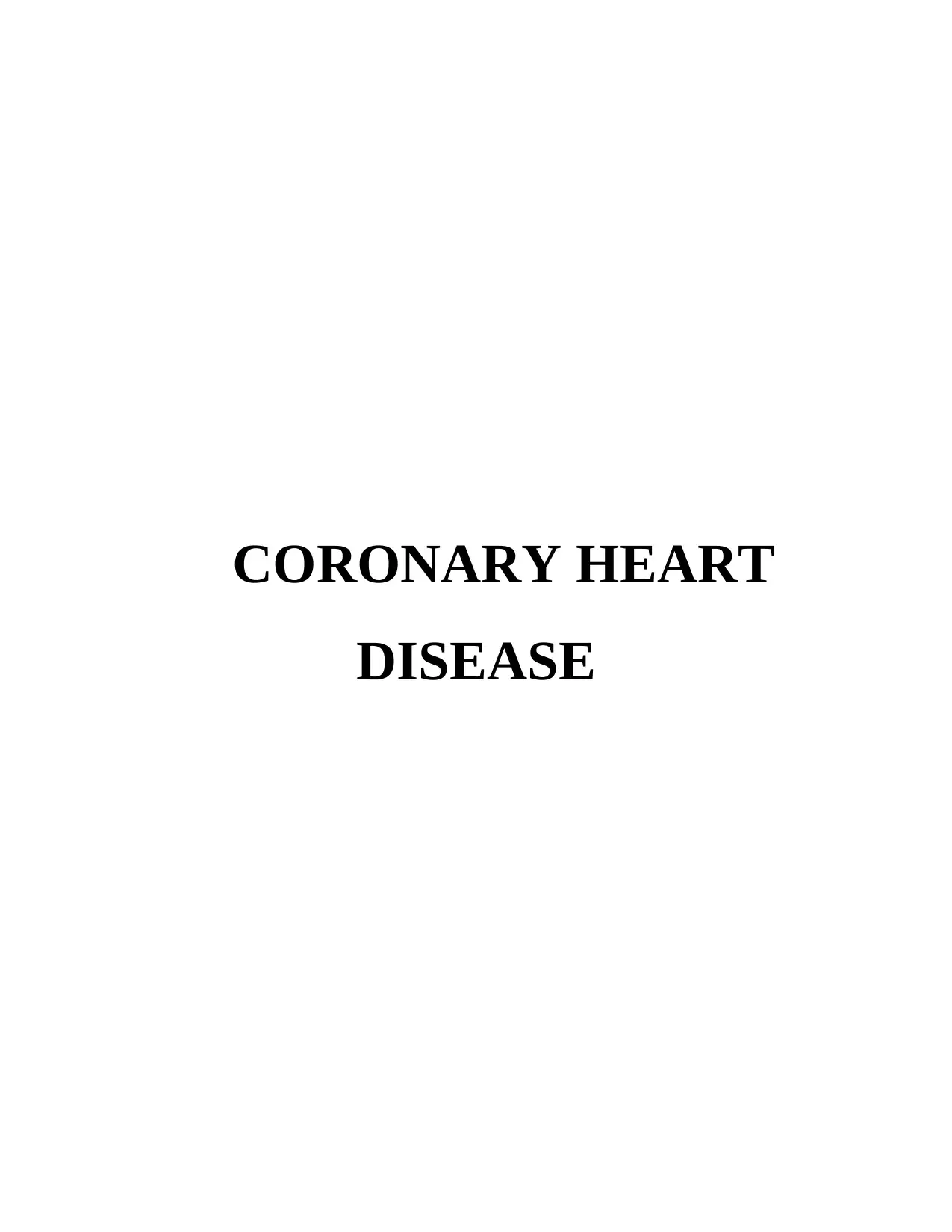
CORONARY HEART
DISEASE
DISEASE
Paraphrase This Document
Need a fresh take? Get an instant paraphrase of this document with our AI Paraphraser
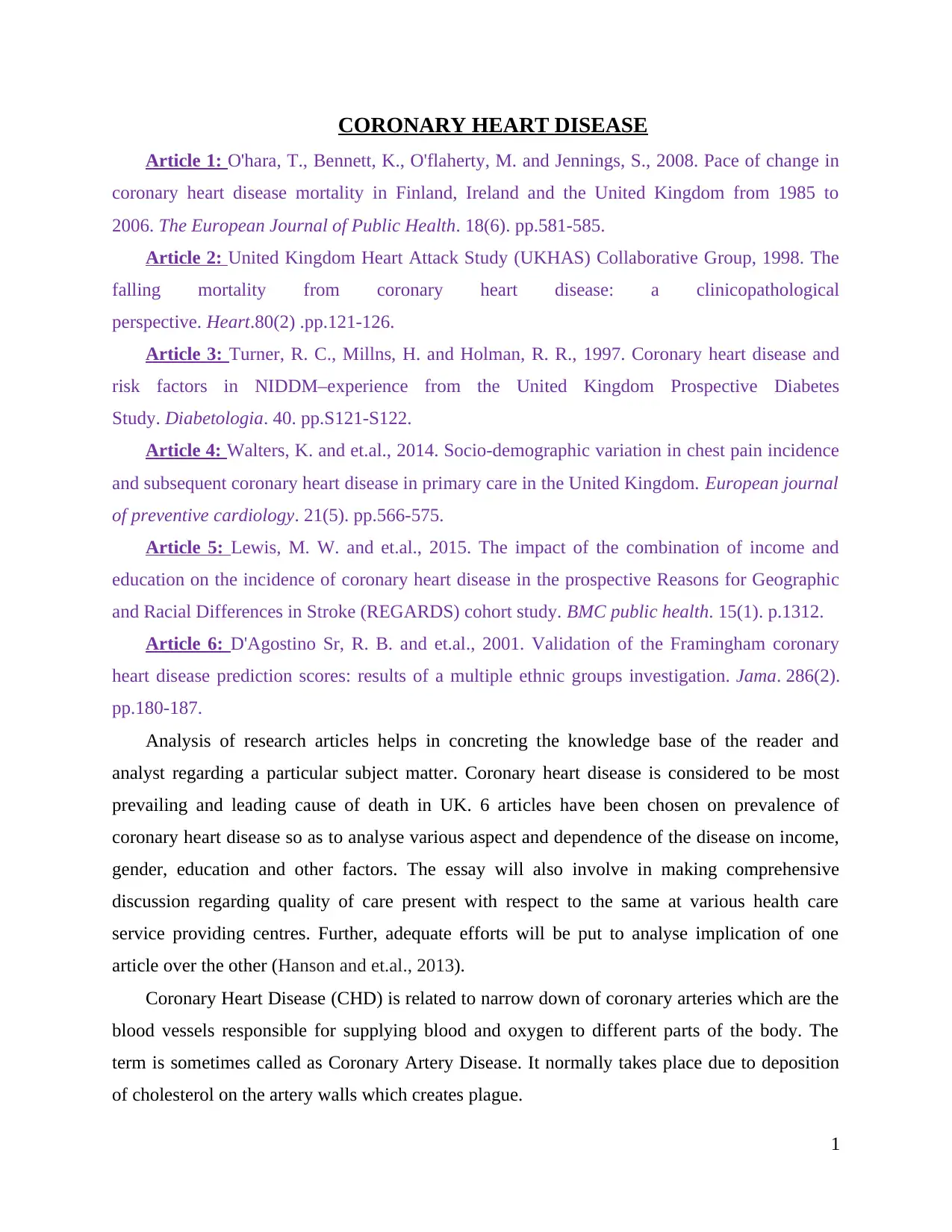
CORONARY HEART DISEASE
Article 1: O'hara, T., Bennett, K., O'flaherty, M. and Jennings, S., 2008. Pace of change in
coronary heart disease mortality in Finland, Ireland and the United Kingdom from 1985 to
2006. The European Journal of Public Health. 18(6). pp.581-585.
Article 2: United Kingdom Heart Attack Study (UKHAS) Collaborative Group, 1998. The
falling mortality from coronary heart disease: a clinicopathological
perspective. Heart.80(2) .pp.121-126.
Article 3: Turner, R. C., Millns, H. and Holman, R. R., 1997. Coronary heart disease and
risk factors in NIDDM–experience from the United Kingdom Prospective Diabetes
Study. Diabetologia. 40. pp.S121-S122.
Article 4: Walters, K. and et.al., 2014. Socio-demographic variation in chest pain incidence
and subsequent coronary heart disease in primary care in the United Kingdom. European journal
of preventive cardiology. 21(5). pp.566-575.
Article 5: Lewis, M. W. and et.al., 2015. The impact of the combination of income and
education on the incidence of coronary heart disease in the prospective Reasons for Geographic
and Racial Differences in Stroke (REGARDS) cohort study. BMC public health. 15(1). p.1312.
Article 6: D'Agostino Sr, R. B. and et.al., 2001. Validation of the Framingham coronary
heart disease prediction scores: results of a multiple ethnic groups investigation. Jama. 286(2).
pp.180-187.
Analysis of research articles helps in concreting the knowledge base of the reader and
analyst regarding a particular subject matter. Coronary heart disease is considered to be most
prevailing and leading cause of death in UK. 6 articles have been chosen on prevalence of
coronary heart disease so as to analyse various aspect and dependence of the disease on income,
gender, education and other factors. The essay will also involve in making comprehensive
discussion regarding quality of care present with respect to the same at various health care
service providing centres. Further, adequate efforts will be put to analyse implication of one
article over the other (Hanson and et.al., 2013).
Coronary Heart Disease (CHD) is related to narrow down of coronary arteries which are the
blood vessels responsible for supplying blood and oxygen to different parts of the body. The
term is sometimes called as Coronary Artery Disease. It normally takes place due to deposition
of cholesterol on the artery walls which creates plague.
1
Article 1: O'hara, T., Bennett, K., O'flaherty, M. and Jennings, S., 2008. Pace of change in
coronary heart disease mortality in Finland, Ireland and the United Kingdom from 1985 to
2006. The European Journal of Public Health. 18(6). pp.581-585.
Article 2: United Kingdom Heart Attack Study (UKHAS) Collaborative Group, 1998. The
falling mortality from coronary heart disease: a clinicopathological
perspective. Heart.80(2) .pp.121-126.
Article 3: Turner, R. C., Millns, H. and Holman, R. R., 1997. Coronary heart disease and
risk factors in NIDDM–experience from the United Kingdom Prospective Diabetes
Study. Diabetologia. 40. pp.S121-S122.
Article 4: Walters, K. and et.al., 2014. Socio-demographic variation in chest pain incidence
and subsequent coronary heart disease in primary care in the United Kingdom. European journal
of preventive cardiology. 21(5). pp.566-575.
Article 5: Lewis, M. W. and et.al., 2015. The impact of the combination of income and
education on the incidence of coronary heart disease in the prospective Reasons for Geographic
and Racial Differences in Stroke (REGARDS) cohort study. BMC public health. 15(1). p.1312.
Article 6: D'Agostino Sr, R. B. and et.al., 2001. Validation of the Framingham coronary
heart disease prediction scores: results of a multiple ethnic groups investigation. Jama. 286(2).
pp.180-187.
Analysis of research articles helps in concreting the knowledge base of the reader and
analyst regarding a particular subject matter. Coronary heart disease is considered to be most
prevailing and leading cause of death in UK. 6 articles have been chosen on prevalence of
coronary heart disease so as to analyse various aspect and dependence of the disease on income,
gender, education and other factors. The essay will also involve in making comprehensive
discussion regarding quality of care present with respect to the same at various health care
service providing centres. Further, adequate efforts will be put to analyse implication of one
article over the other (Hanson and et.al., 2013).
Coronary Heart Disease (CHD) is related to narrow down of coronary arteries which are the
blood vessels responsible for supplying blood and oxygen to different parts of the body. The
term is sometimes called as Coronary Artery Disease. It normally takes place due to deposition
of cholesterol on the artery walls which creates plague.
1
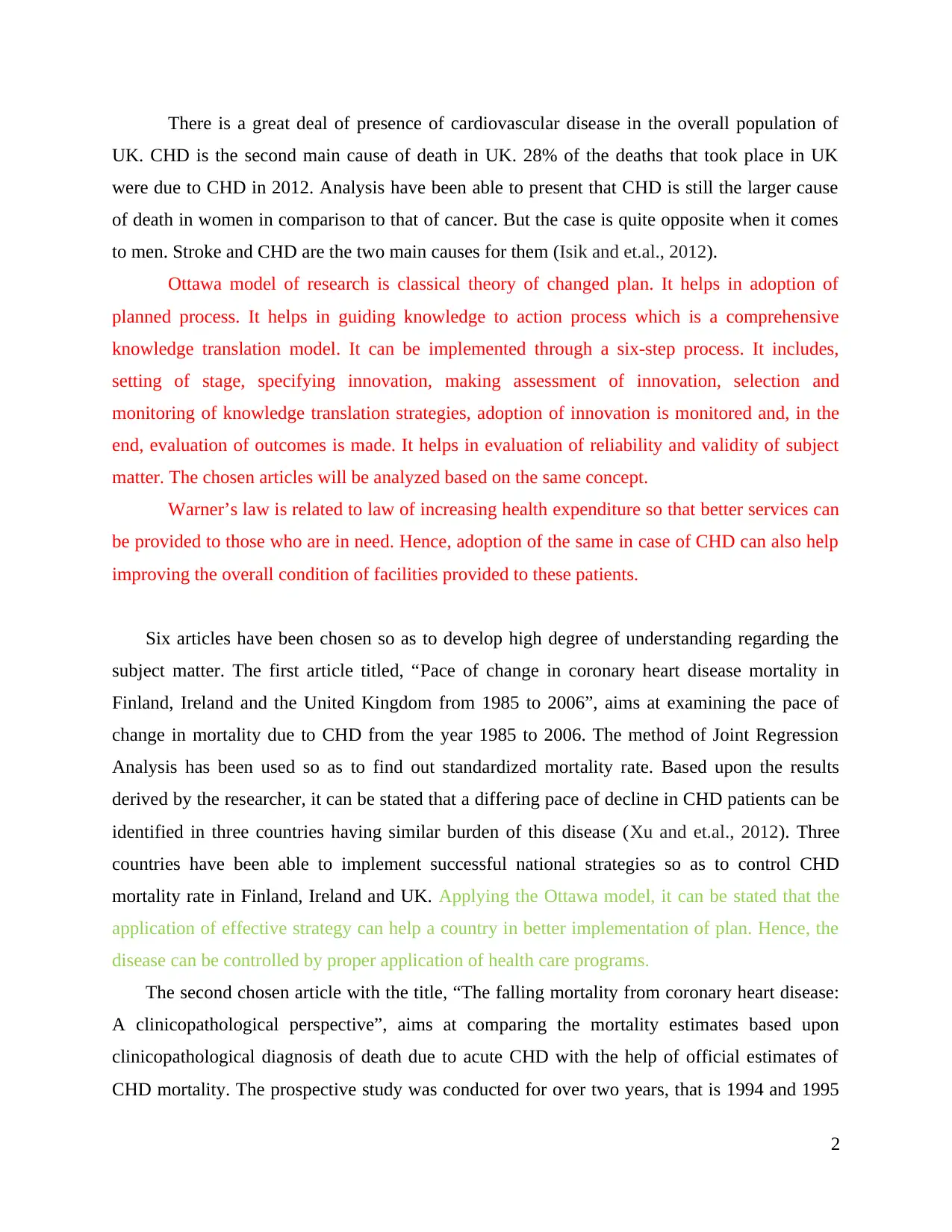
There is a great deal of presence of cardiovascular disease in the overall population of
UK. CHD is the second main cause of death in UK. 28% of the deaths that took place in UK
were due to CHD in 2012. Analysis have been able to present that CHD is still the larger cause
of death in women in comparison to that of cancer. But the case is quite opposite when it comes
to men. Stroke and CHD are the two main causes for them (Isik and et.al., 2012).
Ottawa model of research is classical theory of changed plan. It helps in adoption of
planned process. It helps in guiding knowledge to action process which is a comprehensive
knowledge translation model. It can be implemented through a six-step process. It includes,
setting of stage, specifying innovation, making assessment of innovation, selection and
monitoring of knowledge translation strategies, adoption of innovation is monitored and, in the
end, evaluation of outcomes is made. It helps in evaluation of reliability and validity of subject
matter. The chosen articles will be analyzed based on the same concept.
Warner’s law is related to law of increasing health expenditure so that better services can
be provided to those who are in need. Hence, adoption of the same in case of CHD can also help
improving the overall condition of facilities provided to these patients.
Six articles have been chosen so as to develop high degree of understanding regarding the
subject matter. The first article titled, “Pace of change in coronary heart disease mortality in
Finland, Ireland and the United Kingdom from 1985 to 2006”, aims at examining the pace of
change in mortality due to CHD from the year 1985 to 2006. The method of Joint Regression
Analysis has been used so as to find out standardized mortality rate. Based upon the results
derived by the researcher, it can be stated that a differing pace of decline in CHD patients can be
identified in three countries having similar burden of this disease (Xu and et.al., 2012). Three
countries have been able to implement successful national strategies so as to control CHD
mortality rate in Finland, Ireland and UK. Applying the Ottawa model, it can be stated that the
application of effective strategy can help a country in better implementation of plan. Hence, the
disease can be controlled by proper application of health care programs.
The second chosen article with the title, “The falling mortality from coronary heart disease:
A clinicopathological perspective”, aims at comparing the mortality estimates based upon
clinicopathological diagnosis of death due to acute CHD with the help of official estimates of
CHD mortality. The prospective study was conducted for over two years, that is 1994 and 1995
2
UK. CHD is the second main cause of death in UK. 28% of the deaths that took place in UK
were due to CHD in 2012. Analysis have been able to present that CHD is still the larger cause
of death in women in comparison to that of cancer. But the case is quite opposite when it comes
to men. Stroke and CHD are the two main causes for them (Isik and et.al., 2012).
Ottawa model of research is classical theory of changed plan. It helps in adoption of
planned process. It helps in guiding knowledge to action process which is a comprehensive
knowledge translation model. It can be implemented through a six-step process. It includes,
setting of stage, specifying innovation, making assessment of innovation, selection and
monitoring of knowledge translation strategies, adoption of innovation is monitored and, in the
end, evaluation of outcomes is made. It helps in evaluation of reliability and validity of subject
matter. The chosen articles will be analyzed based on the same concept.
Warner’s law is related to law of increasing health expenditure so that better services can
be provided to those who are in need. Hence, adoption of the same in case of CHD can also help
improving the overall condition of facilities provided to these patients.
Six articles have been chosen so as to develop high degree of understanding regarding the
subject matter. The first article titled, “Pace of change in coronary heart disease mortality in
Finland, Ireland and the United Kingdom from 1985 to 2006”, aims at examining the pace of
change in mortality due to CHD from the year 1985 to 2006. The method of Joint Regression
Analysis has been used so as to find out standardized mortality rate. Based upon the results
derived by the researcher, it can be stated that a differing pace of decline in CHD patients can be
identified in three countries having similar burden of this disease (Xu and et.al., 2012). Three
countries have been able to implement successful national strategies so as to control CHD
mortality rate in Finland, Ireland and UK. Applying the Ottawa model, it can be stated that the
application of effective strategy can help a country in better implementation of plan. Hence, the
disease can be controlled by proper application of health care programs.
The second chosen article with the title, “The falling mortality from coronary heart disease:
A clinicopathological perspective”, aims at comparing the mortality estimates based upon
clinicopathological diagnosis of death due to acute CHD with the help of official estimates of
CHD mortality. The prospective study was conducted for over two years, that is 1994 and 1995
2
⊘ This is a preview!⊘
Do you want full access?
Subscribe today to unlock all pages.

Trusted by 1+ million students worldwide
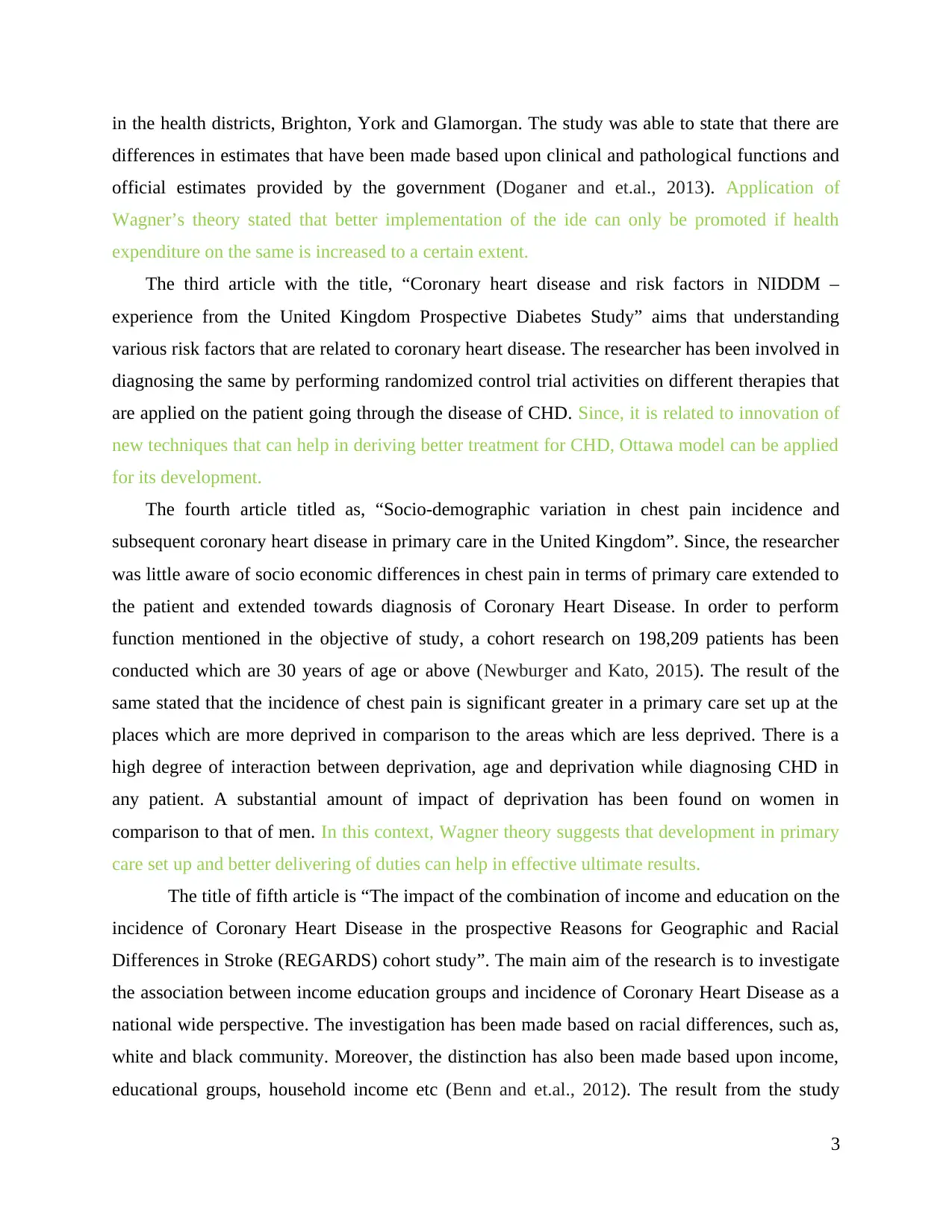
in the health districts, Brighton, York and Glamorgan. The study was able to state that there are
differences in estimates that have been made based upon clinical and pathological functions and
official estimates provided by the government (Doganer and et.al., 2013). Application of
Wagner’s theory stated that better implementation of the ide can only be promoted if health
expenditure on the same is increased to a certain extent.
The third article with the title, “Coronary heart disease and risk factors in NIDDM –
experience from the United Kingdom Prospective Diabetes Study” aims that understanding
various risk factors that are related to coronary heart disease. The researcher has been involved in
diagnosing the same by performing randomized control trial activities on different therapies that
are applied on the patient going through the disease of CHD. Since, it is related to innovation of
new techniques that can help in deriving better treatment for CHD, Ottawa model can be applied
for its development.
The fourth article titled as, “Socio-demographic variation in chest pain incidence and
subsequent coronary heart disease in primary care in the United Kingdom”. Since, the researcher
was little aware of socio economic differences in chest pain in terms of primary care extended to
the patient and extended towards diagnosis of Coronary Heart Disease. In order to perform
function mentioned in the objective of study, a cohort research on 198,209 patients has been
conducted which are 30 years of age or above (Newburger and Kato, 2015). The result of the
same stated that the incidence of chest pain is significant greater in a primary care set up at the
places which are more deprived in comparison to the areas which are less deprived. There is a
high degree of interaction between deprivation, age and deprivation while diagnosing CHD in
any patient. A substantial amount of impact of deprivation has been found on women in
comparison to that of men. In this context, Wagner theory suggests that development in primary
care set up and better delivering of duties can help in effective ultimate results.
The title of fifth article is “The impact of the combination of income and education on the
incidence of Coronary Heart Disease in the prospective Reasons for Geographic and Racial
Differences in Stroke (REGARDS) cohort study”. The main aim of the research is to investigate
the association between income education groups and incidence of Coronary Heart Disease as a
national wide perspective. The investigation has been made based on racial differences, such as,
white and black community. Moreover, the distinction has also been made based upon income,
educational groups, household income etc (Benn and et.al., 2012). The result from the study
3
differences in estimates that have been made based upon clinical and pathological functions and
official estimates provided by the government (Doganer and et.al., 2013). Application of
Wagner’s theory stated that better implementation of the ide can only be promoted if health
expenditure on the same is increased to a certain extent.
The third article with the title, “Coronary heart disease and risk factors in NIDDM –
experience from the United Kingdom Prospective Diabetes Study” aims that understanding
various risk factors that are related to coronary heart disease. The researcher has been involved in
diagnosing the same by performing randomized control trial activities on different therapies that
are applied on the patient going through the disease of CHD. Since, it is related to innovation of
new techniques that can help in deriving better treatment for CHD, Ottawa model can be applied
for its development.
The fourth article titled as, “Socio-demographic variation in chest pain incidence and
subsequent coronary heart disease in primary care in the United Kingdom”. Since, the researcher
was little aware of socio economic differences in chest pain in terms of primary care extended to
the patient and extended towards diagnosis of Coronary Heart Disease. In order to perform
function mentioned in the objective of study, a cohort research on 198,209 patients has been
conducted which are 30 years of age or above (Newburger and Kato, 2015). The result of the
same stated that the incidence of chest pain is significant greater in a primary care set up at the
places which are more deprived in comparison to the areas which are less deprived. There is a
high degree of interaction between deprivation, age and deprivation while diagnosing CHD in
any patient. A substantial amount of impact of deprivation has been found on women in
comparison to that of men. In this context, Wagner theory suggests that development in primary
care set up and better delivering of duties can help in effective ultimate results.
The title of fifth article is “The impact of the combination of income and education on the
incidence of Coronary Heart Disease in the prospective Reasons for Geographic and Racial
Differences in Stroke (REGARDS) cohort study”. The main aim of the research is to investigate
the association between income education groups and incidence of Coronary Heart Disease as a
national wide perspective. The investigation has been made based on racial differences, such as,
white and black community. Moreover, the distinction has also been made based upon income,
educational groups, household income etc (Benn and et.al., 2012). The result from the study
3
Paraphrase This Document
Need a fresh take? Get an instant paraphrase of this document with our AI Paraphraser
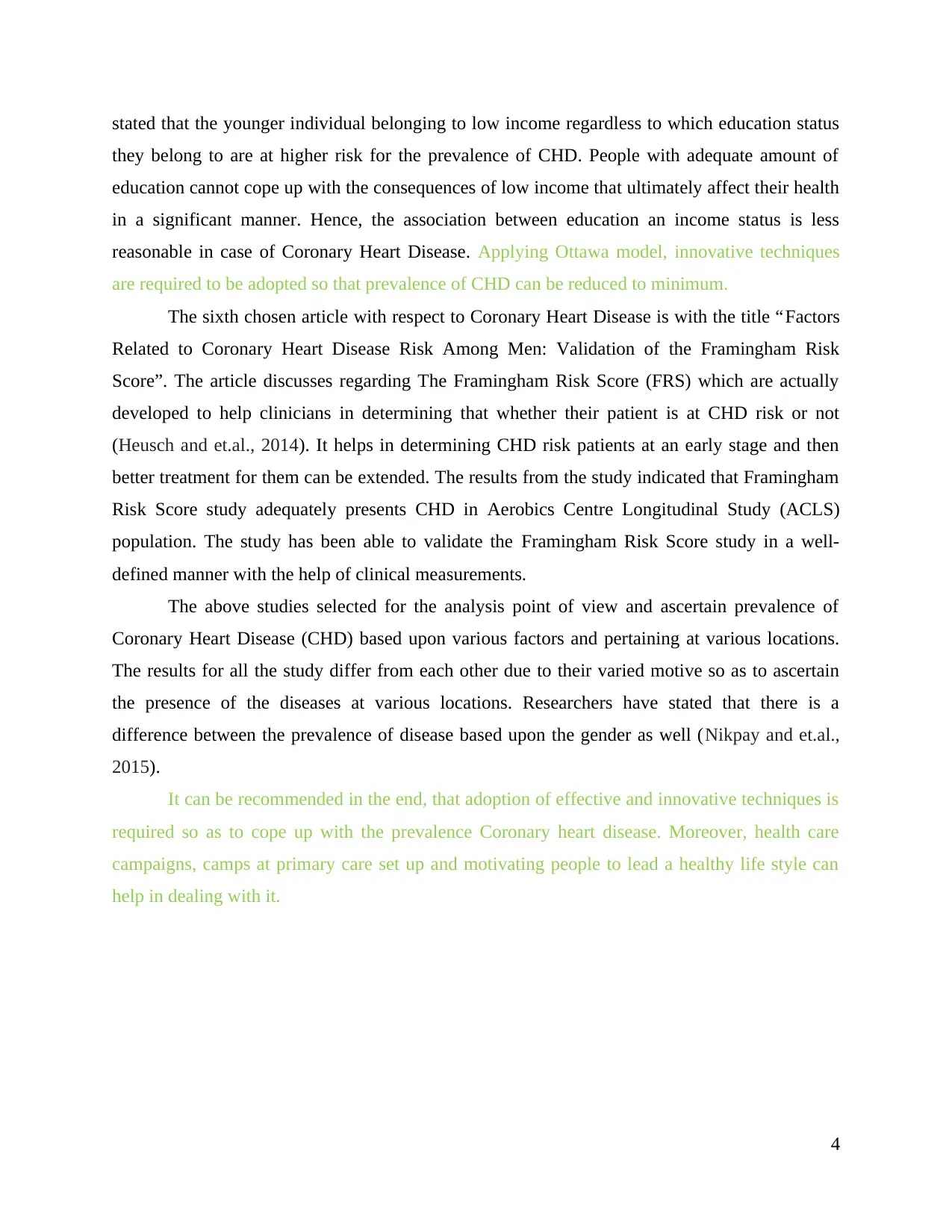
stated that the younger individual belonging to low income regardless to which education status
they belong to are at higher risk for the prevalence of CHD. People with adequate amount of
education cannot cope up with the consequences of low income that ultimately affect their health
in a significant manner. Hence, the association between education an income status is less
reasonable in case of Coronary Heart Disease. Applying Ottawa model, innovative techniques
are required to be adopted so that prevalence of CHD can be reduced to minimum.
The sixth chosen article with respect to Coronary Heart Disease is with the title “Factors
Related to Coronary Heart Disease Risk Among Men: Validation of the Framingham Risk
Score”. The article discusses regarding The Framingham Risk Score (FRS) which are actually
developed to help clinicians in determining that whether their patient is at CHD risk or not
(Heusch and et.al., 2014). It helps in determining CHD risk patients at an early stage and then
better treatment for them can be extended. The results from the study indicated that Framingham
Risk Score study adequately presents CHD in Aerobics Centre Longitudinal Study (ACLS)
population. The study has been able to validate the Framingham Risk Score study in a well-
defined manner with the help of clinical measurements.
The above studies selected for the analysis point of view and ascertain prevalence of
Coronary Heart Disease (CHD) based upon various factors and pertaining at various locations.
The results for all the study differ from each other due to their varied motive so as to ascertain
the presence of the diseases at various locations. Researchers have stated that there is a
difference between the prevalence of disease based upon the gender as well (Nikpay and et.al.,
2015).
It can be recommended in the end, that adoption of effective and innovative techniques is
required so as to cope up with the prevalence Coronary heart disease. Moreover, health care
campaigns, camps at primary care set up and motivating people to lead a healthy life style can
help in dealing with it.
4
they belong to are at higher risk for the prevalence of CHD. People with adequate amount of
education cannot cope up with the consequences of low income that ultimately affect their health
in a significant manner. Hence, the association between education an income status is less
reasonable in case of Coronary Heart Disease. Applying Ottawa model, innovative techniques
are required to be adopted so that prevalence of CHD can be reduced to minimum.
The sixth chosen article with respect to Coronary Heart Disease is with the title “Factors
Related to Coronary Heart Disease Risk Among Men: Validation of the Framingham Risk
Score”. The article discusses regarding The Framingham Risk Score (FRS) which are actually
developed to help clinicians in determining that whether their patient is at CHD risk or not
(Heusch and et.al., 2014). It helps in determining CHD risk patients at an early stage and then
better treatment for them can be extended. The results from the study indicated that Framingham
Risk Score study adequately presents CHD in Aerobics Centre Longitudinal Study (ACLS)
population. The study has been able to validate the Framingham Risk Score study in a well-
defined manner with the help of clinical measurements.
The above studies selected for the analysis point of view and ascertain prevalence of
Coronary Heart Disease (CHD) based upon various factors and pertaining at various locations.
The results for all the study differ from each other due to their varied motive so as to ascertain
the presence of the diseases at various locations. Researchers have stated that there is a
difference between the prevalence of disease based upon the gender as well (Nikpay and et.al.,
2015).
It can be recommended in the end, that adoption of effective and innovative techniques is
required so as to cope up with the prevalence Coronary heart disease. Moreover, health care
campaigns, camps at primary care set up and motivating people to lead a healthy life style can
help in dealing with it.
4
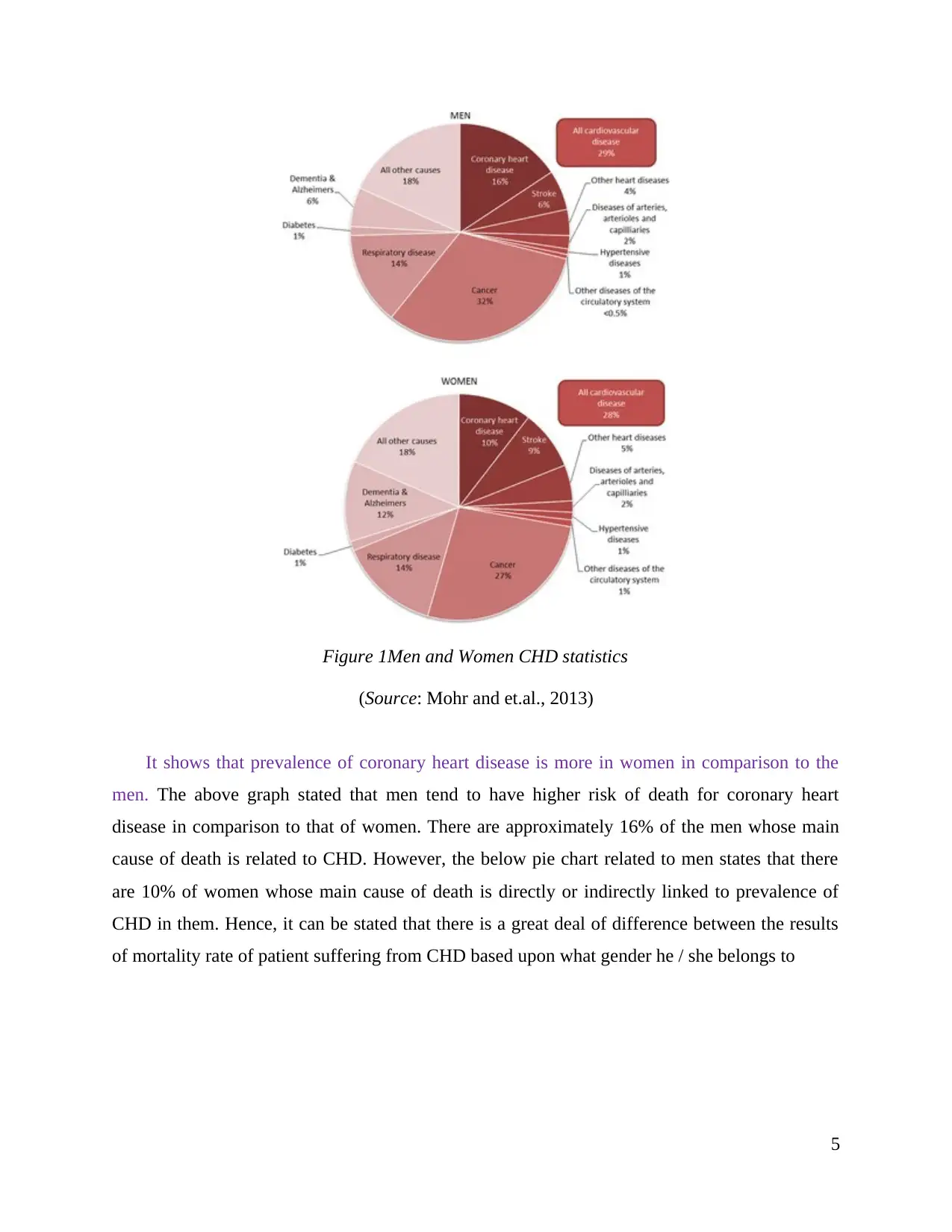
Figure 1Men and Women CHD statistics
(Source: Mohr and et.al., 2013)
It shows that prevalence of coronary heart disease is more in women in comparison to the
men. The above graph stated that men tend to have higher risk of death for coronary heart
disease in comparison to that of women. There are approximately 16% of the men whose main
cause of death is related to CHD. However, the below pie chart related to men states that there
are 10% of women whose main cause of death is directly or indirectly linked to prevalence of
CHD in them. Hence, it can be stated that there is a great deal of difference between the results
of mortality rate of patient suffering from CHD based upon what gender he / she belongs to
5
(Source: Mohr and et.al., 2013)
It shows that prevalence of coronary heart disease is more in women in comparison to the
men. The above graph stated that men tend to have higher risk of death for coronary heart
disease in comparison to that of women. There are approximately 16% of the men whose main
cause of death is related to CHD. However, the below pie chart related to men states that there
are 10% of women whose main cause of death is directly or indirectly linked to prevalence of
CHD in them. Hence, it can be stated that there is a great deal of difference between the results
of mortality rate of patient suffering from CHD based upon what gender he / she belongs to
5
⊘ This is a preview!⊘
Do you want full access?
Subscribe today to unlock all pages.

Trusted by 1+ million students worldwide
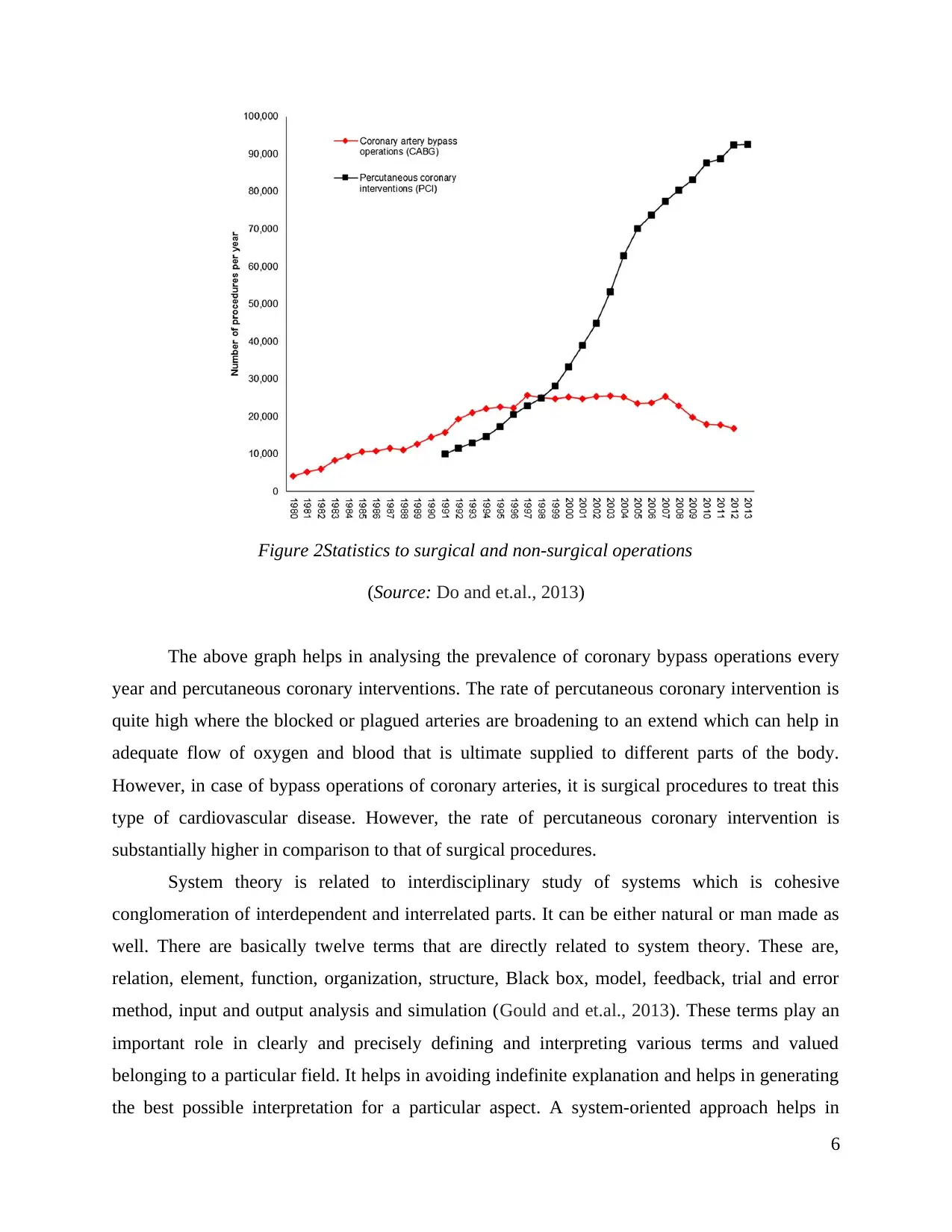
Figure 2Statistics to surgical and non-surgical operations
(Source: Do and et.al., 2013)
The above graph helps in analysing the prevalence of coronary bypass operations every
year and percutaneous coronary interventions. The rate of percutaneous coronary intervention is
quite high where the blocked or plagued arteries are broadening to an extend which can help in
adequate flow of oxygen and blood that is ultimate supplied to different parts of the body.
However, in case of bypass operations of coronary arteries, it is surgical procedures to treat this
type of cardiovascular disease. However, the rate of percutaneous coronary intervention is
substantially higher in comparison to that of surgical procedures.
System theory is related to interdisciplinary study of systems which is cohesive
conglomeration of interdependent and interrelated parts. It can be either natural or man made as
well. There are basically twelve terms that are directly related to system theory. These are,
relation, element, function, organization, structure, Black box, model, feedback, trial and error
method, input and output analysis and simulation (Gould and et.al., 2013). These terms play an
important role in clearly and precisely defining and interpreting various terms and valued
belonging to a particular field. It helps in avoiding indefinite explanation and helps in generating
the best possible interpretation for a particular aspect. A system-oriented approach helps in
6
(Source: Do and et.al., 2013)
The above graph helps in analysing the prevalence of coronary bypass operations every
year and percutaneous coronary interventions. The rate of percutaneous coronary intervention is
quite high where the blocked or plagued arteries are broadening to an extend which can help in
adequate flow of oxygen and blood that is ultimate supplied to different parts of the body.
However, in case of bypass operations of coronary arteries, it is surgical procedures to treat this
type of cardiovascular disease. However, the rate of percutaneous coronary intervention is
substantially higher in comparison to that of surgical procedures.
System theory is related to interdisciplinary study of systems which is cohesive
conglomeration of interdependent and interrelated parts. It can be either natural or man made as
well. There are basically twelve terms that are directly related to system theory. These are,
relation, element, function, organization, structure, Black box, model, feedback, trial and error
method, input and output analysis and simulation (Gould and et.al., 2013). These terms play an
important role in clearly and precisely defining and interpreting various terms and valued
belonging to a particular field. It helps in avoiding indefinite explanation and helps in generating
the best possible interpretation for a particular aspect. A system-oriented approach helps in
6
Paraphrase This Document
Need a fresh take? Get an instant paraphrase of this document with our AI Paraphraser

outlining various stages of interpretation, such as, defining problems, setting the limits, designing
the model and simulation. People having substantial interest in a particular field helps in defining
the field and its subsequent aspect in the critical format as well. Hence, system theory is the
effective method that has been used in the present research to ascertain and critically interpret
various aspects that are related to Coronary Heart Disease (CHD). It also helps in ensuring that
the right interpretation to the various aspects have been made and has reached to the best
possible solution.
The common subject that has been discussed in the above research articles is related to
mortality and morbidity rate of people due to their suffering from Coronary Heart Disease
(CHD). However, the interpretation of all the scholars are significantly different from each other
which has helped in understanding various aspect that are directly or indirectly related to CHD
(Teramoto and et.al., 2014).
The main difference between the identified article is that every article is related to
different subject matter. Some of them are able to give accurate and recent statistics while the
other are too old to be considered. Another major difference that can be found in the article is
that some of them are based upon randomized control trial and the other are just related to
systematic review. It is difficult to compare the content being present in them. But research
methods being used in them can be widely compared to assess the presence of difference in
them.
It can be stated that the articles are inter related due to their subject matter being same
that is Coronary Heart Disease. Hence, the implication can be found on one another where its
reliance can be stated through the mortality rate being introduced due to presence of CHD in all
the patients that have been chosen as sample. Another important aspect that can be analysed from
the same is that their main roe is to ascertain the prevalence of CHD among the patients. It helps
in ensuring that best possible services are provided to the end patients and prevalence of CHD
can be reduced to the minimum.
WHO have been able to provide National Service Framework for Coronary Heart Disease
as a 10 years strategy with the aim to promote health and well-being among people. It mainly
focusses upon raising the quality standards for coronary heart disease care where the main
objective is to reduce its prevalence to the minimum and control stroke and CHD related deaths.
There are various methods that has been adopted by it. The community is involved in setting out
7
the model and simulation. People having substantial interest in a particular field helps in defining
the field and its subsequent aspect in the critical format as well. Hence, system theory is the
effective method that has been used in the present research to ascertain and critically interpret
various aspects that are related to Coronary Heart Disease (CHD). It also helps in ensuring that
the right interpretation to the various aspects have been made and has reached to the best
possible solution.
The common subject that has been discussed in the above research articles is related to
mortality and morbidity rate of people due to their suffering from Coronary Heart Disease
(CHD). However, the interpretation of all the scholars are significantly different from each other
which has helped in understanding various aspect that are directly or indirectly related to CHD
(Teramoto and et.al., 2014).
The main difference between the identified article is that every article is related to
different subject matter. Some of them are able to give accurate and recent statistics while the
other are too old to be considered. Another major difference that can be found in the article is
that some of them are based upon randomized control trial and the other are just related to
systematic review. It is difficult to compare the content being present in them. But research
methods being used in them can be widely compared to assess the presence of difference in
them.
It can be stated that the articles are inter related due to their subject matter being same
that is Coronary Heart Disease. Hence, the implication can be found on one another where its
reliance can be stated through the mortality rate being introduced due to presence of CHD in all
the patients that have been chosen as sample. Another important aspect that can be analysed from
the same is that their main roe is to ascertain the prevalence of CHD among the patients. It helps
in ensuring that best possible services are provided to the end patients and prevalence of CHD
can be reduced to the minimum.
WHO have been able to provide National Service Framework for Coronary Heart Disease
as a 10 years strategy with the aim to promote health and well-being among people. It mainly
focusses upon raising the quality standards for coronary heart disease care where the main
objective is to reduce its prevalence to the minimum and control stroke and CHD related deaths.
There are various methods that has been adopted by it. The community is involved in setting out
7
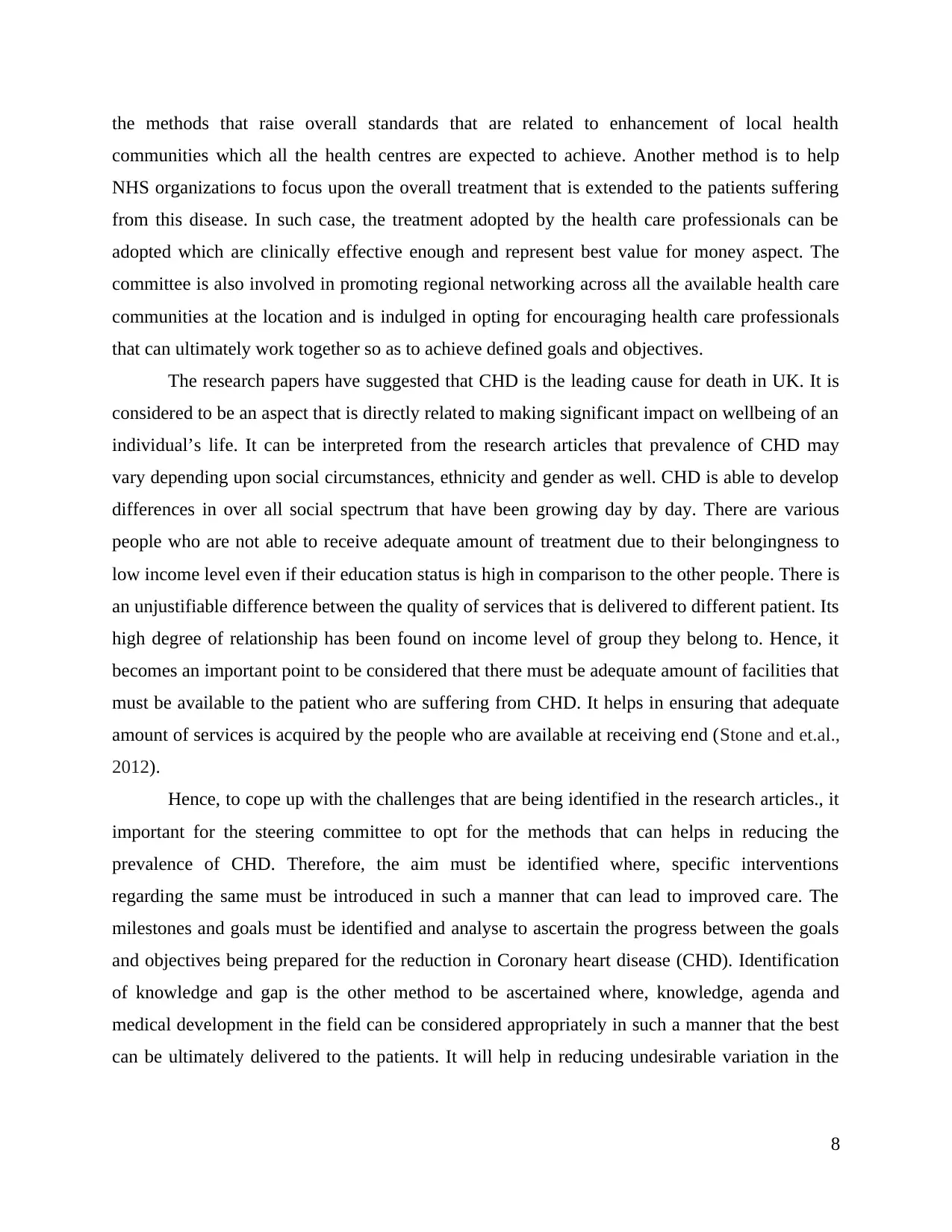
the methods that raise overall standards that are related to enhancement of local health
communities which all the health centres are expected to achieve. Another method is to help
NHS organizations to focus upon the overall treatment that is extended to the patients suffering
from this disease. In such case, the treatment adopted by the health care professionals can be
adopted which are clinically effective enough and represent best value for money aspect. The
committee is also involved in promoting regional networking across all the available health care
communities at the location and is indulged in opting for encouraging health care professionals
that can ultimately work together so as to achieve defined goals and objectives.
The research papers have suggested that CHD is the leading cause for death in UK. It is
considered to be an aspect that is directly related to making significant impact on wellbeing of an
individual’s life. It can be interpreted from the research articles that prevalence of CHD may
vary depending upon social circumstances, ethnicity and gender as well. CHD is able to develop
differences in over all social spectrum that have been growing day by day. There are various
people who are not able to receive adequate amount of treatment due to their belongingness to
low income level even if their education status is high in comparison to the other people. There is
an unjustifiable difference between the quality of services that is delivered to different patient. Its
high degree of relationship has been found on income level of group they belong to. Hence, it
becomes an important point to be considered that there must be adequate amount of facilities that
must be available to the patient who are suffering from CHD. It helps in ensuring that adequate
amount of services is acquired by the people who are available at receiving end (Stone and et.al.,
2012).
Hence, to cope up with the challenges that are being identified in the research articles., it
important for the steering committee to opt for the methods that can helps in reducing the
prevalence of CHD. Therefore, the aim must be identified where, specific interventions
regarding the same must be introduced in such a manner that can lead to improved care. The
milestones and goals must be identified and analyse to ascertain the progress between the goals
and objectives being prepared for the reduction in Coronary heart disease (CHD). Identification
of knowledge and gap is the other method to be ascertained where, knowledge, agenda and
medical development in the field can be considered appropriately in such a manner that the best
can be ultimately delivered to the patients. It will help in reducing undesirable variation in the
8
communities which all the health centres are expected to achieve. Another method is to help
NHS organizations to focus upon the overall treatment that is extended to the patients suffering
from this disease. In such case, the treatment adopted by the health care professionals can be
adopted which are clinically effective enough and represent best value for money aspect. The
committee is also involved in promoting regional networking across all the available health care
communities at the location and is indulged in opting for encouraging health care professionals
that can ultimately work together so as to achieve defined goals and objectives.
The research papers have suggested that CHD is the leading cause for death in UK. It is
considered to be an aspect that is directly related to making significant impact on wellbeing of an
individual’s life. It can be interpreted from the research articles that prevalence of CHD may
vary depending upon social circumstances, ethnicity and gender as well. CHD is able to develop
differences in over all social spectrum that have been growing day by day. There are various
people who are not able to receive adequate amount of treatment due to their belongingness to
low income level even if their education status is high in comparison to the other people. There is
an unjustifiable difference between the quality of services that is delivered to different patient. Its
high degree of relationship has been found on income level of group they belong to. Hence, it
becomes an important point to be considered that there must be adequate amount of facilities that
must be available to the patient who are suffering from CHD. It helps in ensuring that adequate
amount of services is acquired by the people who are available at receiving end (Stone and et.al.,
2012).
Hence, to cope up with the challenges that are being identified in the research articles., it
important for the steering committee to opt for the methods that can helps in reducing the
prevalence of CHD. Therefore, the aim must be identified where, specific interventions
regarding the same must be introduced in such a manner that can lead to improved care. The
milestones and goals must be identified and analyse to ascertain the progress between the goals
and objectives being prepared for the reduction in Coronary heart disease (CHD). Identification
of knowledge and gap is the other method to be ascertained where, knowledge, agenda and
medical development in the field can be considered appropriately in such a manner that the best
can be ultimately delivered to the patients. It will help in reducing undesirable variation in the
8
⊘ This is a preview!⊘
Do you want full access?
Subscribe today to unlock all pages.

Trusted by 1+ million students worldwide

mortality rate due to unavailability of adequate resources at various health care community
centres at different locations (Coronary Heart Disease, 2015).
In various cases, it becomes important to opt for quality of services that can ultimately
help in generating adequate amount of quality results. Well trained staff, quality health care
professionals and high technical standards can help in clinically treating the patients at very
initial stage. Adequate interaction between clinicians and patients can help in generating the best
possible outcomes. Another important role can be played by health care programmes where
people must be made aware of various sign and symptoms that can help them in figuring out
CHD at initial stage. It will help reducing the mortality rate due to prevalence of CHD at quite a
lower rate. In such cases, CHD prevention and treatment policies come top rescue and constant
upgradation in the same help in effectively making a set where best possible services at
minimum prices can be provided to the patients.
There are four main principles that have been underpinned by NSF with respect to CHD.
One of the most important principle is related to reducing the burden of CHD from NSF as the
organization is not only responsible for one disease. Hence, it requires actions from the side of
the society as well. Second is quality of services have high dependence on readily access to
appropriate services, calibre of interaction between clinicians and patients and quality of
environment in which services are actually delivered to the end users (Heusch and et.al., 2014).
Third principle of NSF is that excellence is required to be adopted by the clinicians working on
CHD since simple steps involved in the procedure can help in ascertaining that whether the best
possible services are adopted by the patient in the end or not. The fourth and last principle of
NSF is to deliver services of care in most structural and systematic manner. It will help in
enduring the best possible results that can help in reducing the variations in final output of CHD
patients as well.
Robust evidence has been found regarding high prevalence of CHD in UK. In such cases,
it becomes important to them to opt for the steps that can ultimately reduce its prevalence. Some
of the common resources that can be required by NSF so as to implement the same in national
programme are, finance, revenue, capital, workforce planning, education, training, research and
development, practical tools, clinical decision support system and information of health.
Adoption of these resources can help in reducing the prevalence of CHD. Moreover, it can also
help in better implementation of methods that can reduce its occurrence. Moreover, it will also
9
centres at different locations (Coronary Heart Disease, 2015).
In various cases, it becomes important to opt for quality of services that can ultimately
help in generating adequate amount of quality results. Well trained staff, quality health care
professionals and high technical standards can help in clinically treating the patients at very
initial stage. Adequate interaction between clinicians and patients can help in generating the best
possible outcomes. Another important role can be played by health care programmes where
people must be made aware of various sign and symptoms that can help them in figuring out
CHD at initial stage. It will help reducing the mortality rate due to prevalence of CHD at quite a
lower rate. In such cases, CHD prevention and treatment policies come top rescue and constant
upgradation in the same help in effectively making a set where best possible services at
minimum prices can be provided to the patients.
There are four main principles that have been underpinned by NSF with respect to CHD.
One of the most important principle is related to reducing the burden of CHD from NSF as the
organization is not only responsible for one disease. Hence, it requires actions from the side of
the society as well. Second is quality of services have high dependence on readily access to
appropriate services, calibre of interaction between clinicians and patients and quality of
environment in which services are actually delivered to the end users (Heusch and et.al., 2014).
Third principle of NSF is that excellence is required to be adopted by the clinicians working on
CHD since simple steps involved in the procedure can help in ascertaining that whether the best
possible services are adopted by the patient in the end or not. The fourth and last principle of
NSF is to deliver services of care in most structural and systematic manner. It will help in
enduring the best possible results that can help in reducing the variations in final output of CHD
patients as well.
Robust evidence has been found regarding high prevalence of CHD in UK. In such cases,
it becomes important to them to opt for the steps that can ultimately reduce its prevalence. Some
of the common resources that can be required by NSF so as to implement the same in national
programme are, finance, revenue, capital, workforce planning, education, training, research and
development, practical tools, clinical decision support system and information of health.
Adoption of these resources can help in reducing the prevalence of CHD. Moreover, it can also
help in better implementation of methods that can reduce its occurrence. Moreover, it will also
9
Paraphrase This Document
Need a fresh take? Get an instant paraphrase of this document with our AI Paraphraser
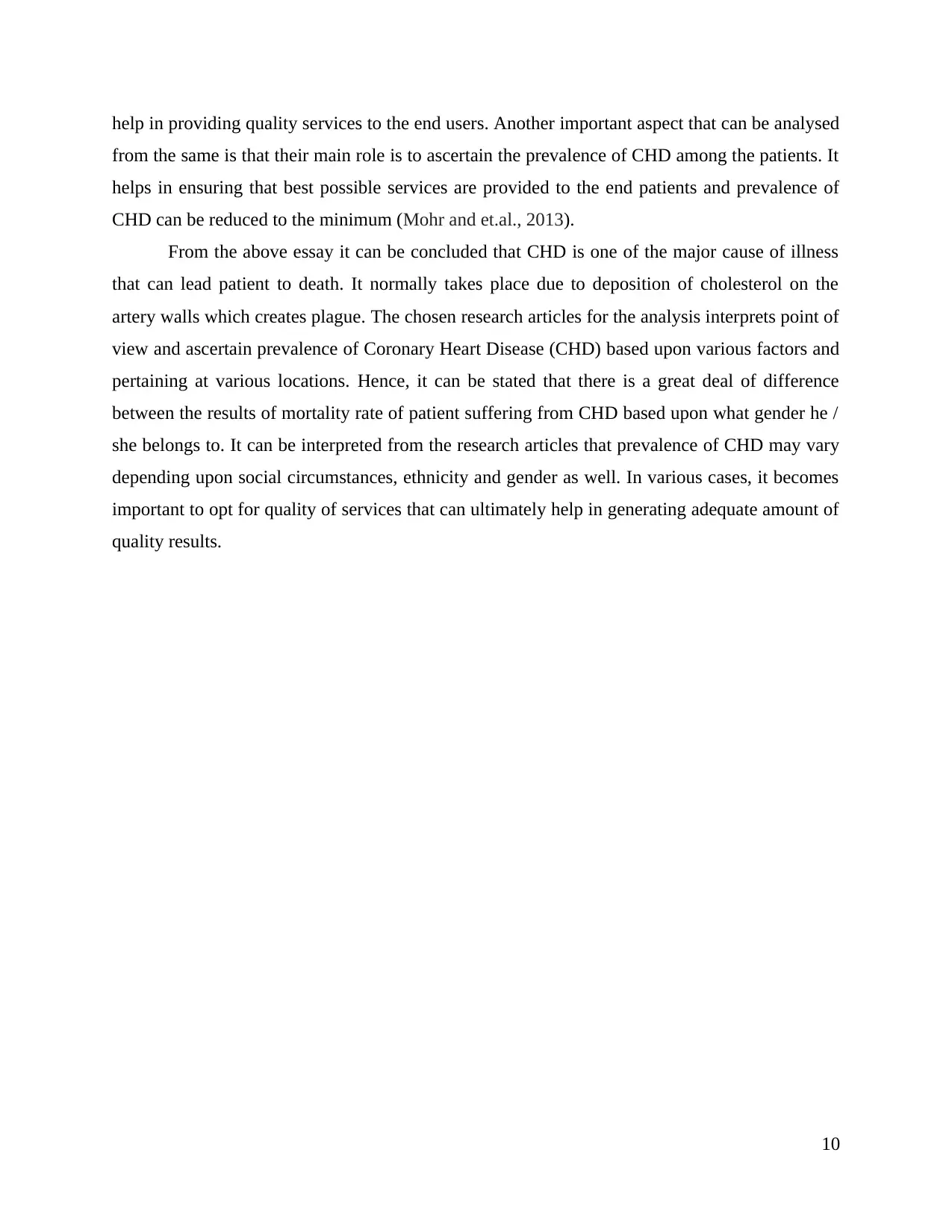
help in providing quality services to the end users. Another important aspect that can be analysed
from the same is that their main role is to ascertain the prevalence of CHD among the patients. It
helps in ensuring that best possible services are provided to the end patients and prevalence of
CHD can be reduced to the minimum (Mohr and et.al., 2013).
From the above essay it can be concluded that CHD is one of the major cause of illness
that can lead patient to death. It normally takes place due to deposition of cholesterol on the
artery walls which creates plague. The chosen research articles for the analysis interprets point of
view and ascertain prevalence of Coronary Heart Disease (CHD) based upon various factors and
pertaining at various locations. Hence, it can be stated that there is a great deal of difference
between the results of mortality rate of patient suffering from CHD based upon what gender he /
she belongs to. It can be interpreted from the research articles that prevalence of CHD may vary
depending upon social circumstances, ethnicity and gender as well. In various cases, it becomes
important to opt for quality of services that can ultimately help in generating adequate amount of
quality results.
10
from the same is that their main role is to ascertain the prevalence of CHD among the patients. It
helps in ensuring that best possible services are provided to the end patients and prevalence of
CHD can be reduced to the minimum (Mohr and et.al., 2013).
From the above essay it can be concluded that CHD is one of the major cause of illness
that can lead patient to death. It normally takes place due to deposition of cholesterol on the
artery walls which creates plague. The chosen research articles for the analysis interprets point of
view and ascertain prevalence of Coronary Heart Disease (CHD) based upon various factors and
pertaining at various locations. Hence, it can be stated that there is a great deal of difference
between the results of mortality rate of patient suffering from CHD based upon what gender he /
she belongs to. It can be interpreted from the research articles that prevalence of CHD may vary
depending upon social circumstances, ethnicity and gender as well. In various cases, it becomes
important to opt for quality of services that can ultimately help in generating adequate amount of
quality results.
10
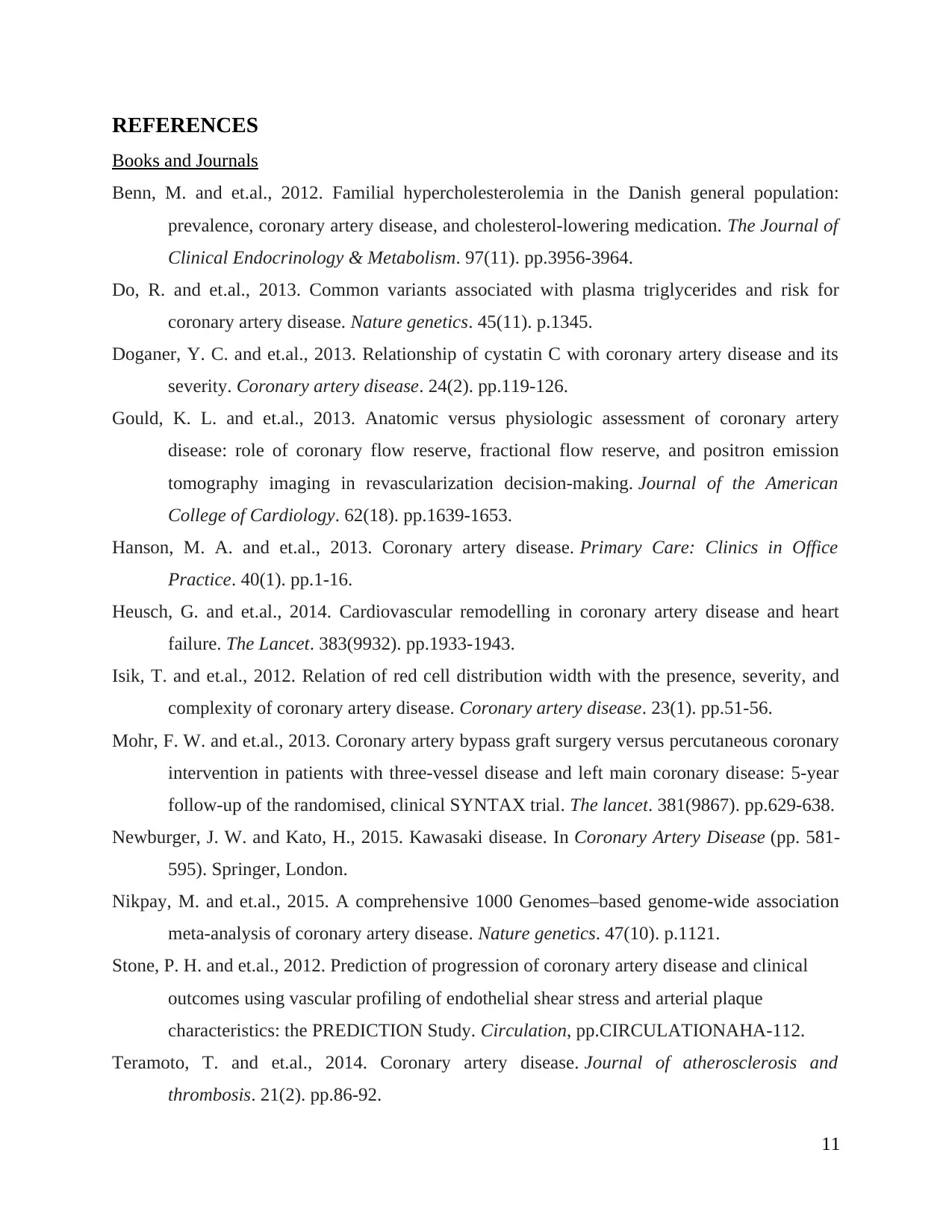
REFERENCES
Books and Journals
Benn, M. and et.al., 2012. Familial hypercholesterolemia in the Danish general population:
prevalence, coronary artery disease, and cholesterol-lowering medication. The Journal of
Clinical Endocrinology & Metabolism. 97(11). pp.3956-3964.
Do, R. and et.al., 2013. Common variants associated with plasma triglycerides and risk for
coronary artery disease. Nature genetics. 45(11). p.1345.
Doganer, Y. C. and et.al., 2013. Relationship of cystatin C with coronary artery disease and its
severity. Coronary artery disease. 24(2). pp.119-126.
Gould, K. L. and et.al., 2013. Anatomic versus physiologic assessment of coronary artery
disease: role of coronary flow reserve, fractional flow reserve, and positron emission
tomography imaging in revascularization decision-making. Journal of the American
College of Cardiology. 62(18). pp.1639-1653.
Hanson, M. A. and et.al., 2013. Coronary artery disease. Primary Care: Clinics in Office
Practice. 40(1). pp.1-16.
Heusch, G. and et.al., 2014. Cardiovascular remodelling in coronary artery disease and heart
failure. The Lancet. 383(9932). pp.1933-1943.
Isik, T. and et.al., 2012. Relation of red cell distribution width with the presence, severity, and
complexity of coronary artery disease. Coronary artery disease. 23(1). pp.51-56.
Mohr, F. W. and et.al., 2013. Coronary artery bypass graft surgery versus percutaneous coronary
intervention in patients with three-vessel disease and left main coronary disease: 5-year
follow-up of the randomised, clinical SYNTAX trial. The lancet. 381(9867). pp.629-638.
Newburger, J. W. and Kato, H., 2015. Kawasaki disease. In Coronary Artery Disease (pp. 581-
595). Springer, London.
Nikpay, M. and et.al., 2015. A comprehensive 1000 Genomes–based genome-wide association
meta-analysis of coronary artery disease. Nature genetics. 47(10). p.1121.
Stone, P. H. and et.al., 2012. Prediction of progression of coronary artery disease and clinical
outcomes using vascular profiling of endothelial shear stress and arterial plaque
characteristics: the PREDICTION Study. Circulation, pp.CIRCULATIONAHA-112.
Teramoto, T. and et.al., 2014. Coronary artery disease. Journal of atherosclerosis and
thrombosis. 21(2). pp.86-92.
11
Books and Journals
Benn, M. and et.al., 2012. Familial hypercholesterolemia in the Danish general population:
prevalence, coronary artery disease, and cholesterol-lowering medication. The Journal of
Clinical Endocrinology & Metabolism. 97(11). pp.3956-3964.
Do, R. and et.al., 2013. Common variants associated with plasma triglycerides and risk for
coronary artery disease. Nature genetics. 45(11). p.1345.
Doganer, Y. C. and et.al., 2013. Relationship of cystatin C with coronary artery disease and its
severity. Coronary artery disease. 24(2). pp.119-126.
Gould, K. L. and et.al., 2013. Anatomic versus physiologic assessment of coronary artery
disease: role of coronary flow reserve, fractional flow reserve, and positron emission
tomography imaging in revascularization decision-making. Journal of the American
College of Cardiology. 62(18). pp.1639-1653.
Hanson, M. A. and et.al., 2013. Coronary artery disease. Primary Care: Clinics in Office
Practice. 40(1). pp.1-16.
Heusch, G. and et.al., 2014. Cardiovascular remodelling in coronary artery disease and heart
failure. The Lancet. 383(9932). pp.1933-1943.
Isik, T. and et.al., 2012. Relation of red cell distribution width with the presence, severity, and
complexity of coronary artery disease. Coronary artery disease. 23(1). pp.51-56.
Mohr, F. W. and et.al., 2013. Coronary artery bypass graft surgery versus percutaneous coronary
intervention in patients with three-vessel disease and left main coronary disease: 5-year
follow-up of the randomised, clinical SYNTAX trial. The lancet. 381(9867). pp.629-638.
Newburger, J. W. and Kato, H., 2015. Kawasaki disease. In Coronary Artery Disease (pp. 581-
595). Springer, London.
Nikpay, M. and et.al., 2015. A comprehensive 1000 Genomes–based genome-wide association
meta-analysis of coronary artery disease. Nature genetics. 47(10). p.1121.
Stone, P. H. and et.al., 2012. Prediction of progression of coronary artery disease and clinical
outcomes using vascular profiling of endothelial shear stress and arterial plaque
characteristics: the PREDICTION Study. Circulation, pp.CIRCULATIONAHA-112.
Teramoto, T. and et.al., 2014. Coronary artery disease. Journal of atherosclerosis and
thrombosis. 21(2). pp.86-92.
11
⊘ This is a preview!⊘
Do you want full access?
Subscribe today to unlock all pages.

Trusted by 1+ million students worldwide
1 out of 13
Related Documents
Your All-in-One AI-Powered Toolkit for Academic Success.
+13062052269
info@desklib.com
Available 24*7 on WhatsApp / Email
![[object Object]](/_next/static/media/star-bottom.7253800d.svg)
Unlock your academic potential
Copyright © 2020–2025 A2Z Services. All Rights Reserved. Developed and managed by ZUCOL.




